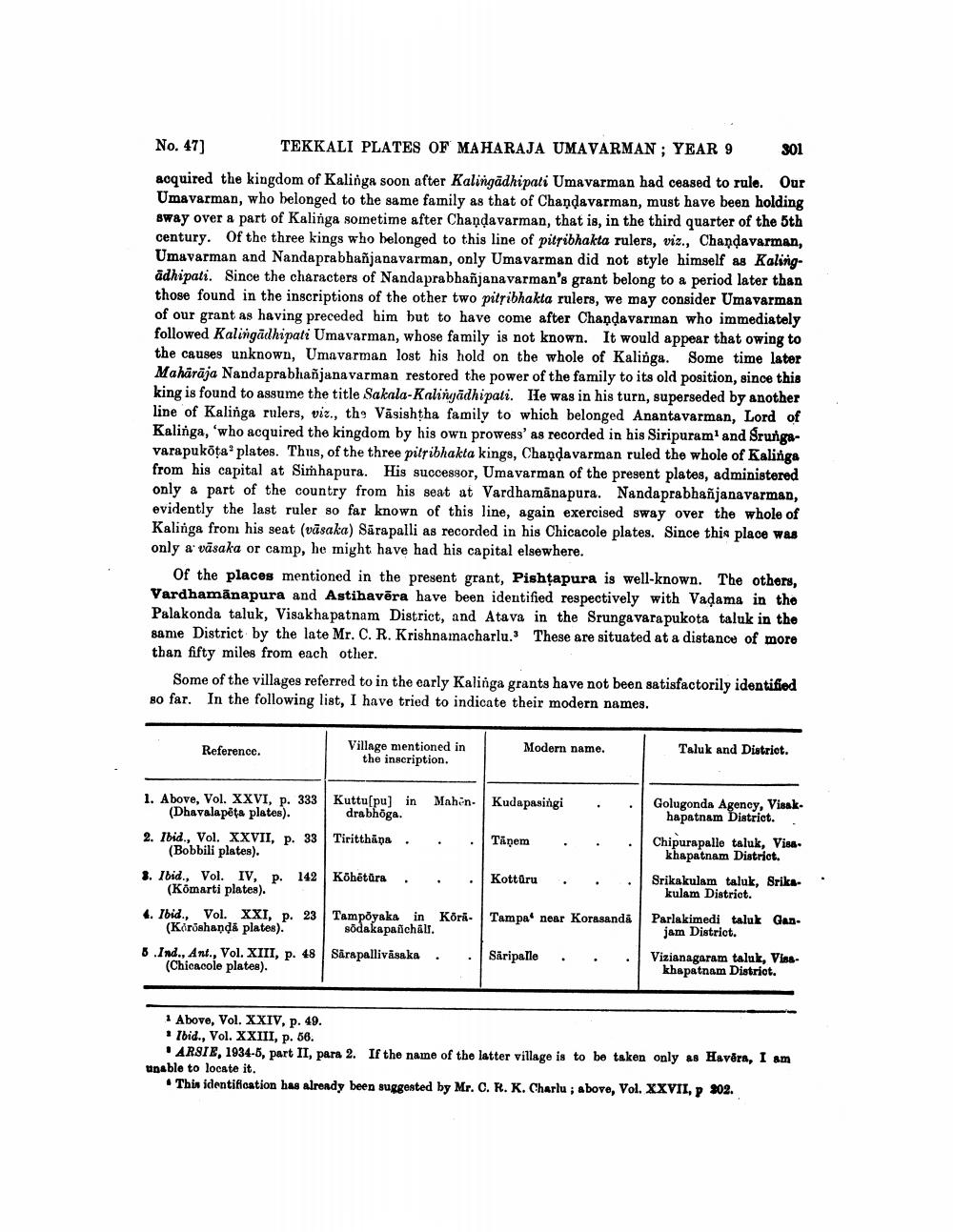________________
No. 47]
TEKKALI PLATES OF MAHARAJA UMAVARMAN : YEAR 9 301 acquired the kingdom of Kalinga soon after Kalingadhipati Umavarman had ceased to rule. Our Umavarman, who belonged to the same family as that of Chandavarman, must have been holding sway over a part of Kalinga sometime after Chandavarman, that is, in the third quarter of the 5th century. Of the three kings who belonged to this line of pitfibhakta rulers, viz., Chandavarman, Umavarman and Nandaprabbañjanavarman, only Umavarman did not style himself as Kalirigadhipati. Since the characters of Nandaprabbañjanavarman's grant belong to a period later than those found in the inscriptions of the other two pithibhakta rulers, we may consider Umavarman of our grant as having preceded him but to have come after Chandavarman who immediately followed Kalingadhipati Umavarman, whose family is not known. It would appear that owing to the causes unknown, Umavarman lost his hold on the whole of Kalinga. Some time later Mahārāja Nandaprabhañjanavarman restored the power of the family to its old position, since this king is found to assume the title Sakala-Kalinyādhipali. He was in his turn, superseded by another line of Kalinga rulers, viz., th, Vāsishtha family to which belonged Anantavarman, Lord of Kalinga, 'who acquired the kingdom by his own prowess' as recorded in his Siripuram' and Srungavarapukota plates. Thus, of the three pitsibhakta kings, Chandavarman ruled the whole of Kalinga from his capital at Simhapura. His successor, Umavarman of the present plates, administered only a part of the country from his seat at Vardhamanapura. Nandaprabhañjanavarman, evidently the last ruler so far known of this line, again exercised sway over the whole of Kalinga from his seat (vāsaka) Sāra palli as recorded in his Chicacole plates. Since this place was only a vāsaka or camp, he might have had his capital elsewhere.
Of the places mentioned in the present grant, Pishtapura is well-known. The others, Vardhamānapura and Astihavēra have been identified respectively with Vadama in the Palakonda taluk, Visakhapatnam District, and Atava in the Srungavara pukota taluk in the same District by the late Mr. C. R. Krishnamacharlu. These are situated at a distance of more than fifty miles from each other.
Some of the villages referred to in the early Kalinga grants have not been satisfactorily identified 80 far. In the following list, I have tried to indicate their modern names.
Reference.
Village mentioned in
the inscription.
Modern name.
Taluk and District.
1. Above, Vol. XXVI, p. 333 Kuttu[pu] in Mahin. Kudapasingi
Kudapasingi . . (Dhavalapēta plates). drabhöga. 2. Ibid., Vol. XXVII, p. 33 Tiritthapa . . Tänem
(Bobbili plates). 3. Ibid., Vol. IV, p. 142 Kohētūra
Kottaru . . . (Komarti plates). 4. Ibid., Vol. XXI, p. 23 Tampoyaka in Kora. Tampa noar Korasanda
(Kóroshandå plates). sodakapanchali. 8. Ind., Ant., Vol. XIII, p. 48 Särapallivāsaka . Säripalle .
(Chicacole plates).
Golugonda Agency, Visak
hapatnam District. Chipurapalle taluk, Visa
khapatnam District. Srikakulam taluk, Srike-
kulam District.
.
Parlakimedi taluk Gas
jam District.
Vizianagaram taluk, Viss
khapatnam District.
1 Above, Vol. XXIV, p. 49. * Ibid., Vol. XXIII, p. 56.
ARSIE, 1934-5, part II, para 2. If the name of the latter village is to be taken only as Havēra, I am unable to locate it.
• Thin identification has already been suggested by Mr. C. R. K. Charlu ; above, Vol. XXVII, p202.




